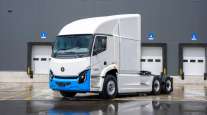Senior Reporter
NACFE Issues Guidance Report on Battery-Electric Trucks

LONG BEACH, Calif. — The North American Council for Freight Efficiency issued its first guidance report that details the impact on the commercial-vehicle sector of battery-electric trucks — an emerging technology that is prompting interest, investments and questions.
“While considerable capital is being invested as a result of commercial battery-electric vehicles, information is rife with biases and vested interests,” according to the report.
The group announced the availability of the guidance report on Classes 3-8 trucks during the Advanced Clean Transportation Expo here.

The report — Electric Trucks: Where They Make Sense — found some common negative assumptions regarding electric trucks that needed clarification, including that electric trucks laden with batteries are much heavier than similar diesel trucks — which can carry up to 8,000 pounds of operational fluids plus components not found on electric trucks.
MORE FROM ACT EXPO: Electrification finds its ground zero in California
RELATED: Kenworth displays T680 hybrid-electric tractor
READ MORE: DTNA showcases alternative-fuel Cascadia models
The report discusses nine other pros and cons of electric trucks. NACFE also developed a parity chart of 22 attributes that buyers are looking for and explored at what point in the future an electric truck would match a gas or diesel baseline.
“We looked at all the available technology research that has been done. We did interviews with the manufacturers. And also looked at the fleet perspective on electric trucks, asking what they thought would be their experience and data on electric trucks when they used them down the road,” said NACFE Executive Director Mike Roeth.
“It was different for us and it was exciting doing the work,” he added. “We always say the duty cycle matters and a fleet’s business model matters.”
Separately, NACFE has issued 16 confidence reports that cover about 70 technologies and is following a total of 85 technologies. The guidance report is available on the group’s website, nacfe.org.
NACFE said it has begun a more specific report looking into the total cost of ownership of electrified medium-duty trucks — a segment which NACFE believes will be the first to advance electric-truck use.
A report on heavy-duty electric tractors will be next.
Meanwhile, the latest guidance report predicted the charging infrastructure for battery-electric trucks would evolve once third-parties, utilities or even truck makers stepped in to provide the necessary means for customers.
The group also found that making a decision about whether to use a battery-electric truck requires a carrier to undertake a thorough analysis of its current operating conditions.
At the same time, the determination of net cost-benefit of CBEVs requires more effort than traditionally limited return-on-investment calculations, according to the report.
“Multiple factors need to be included, from straightforward costs such as grants, incentives and taxes, to hard-to-quantify costs such as emissions credits, brand image, liability costs, disposal costs, indirect costs, driver/technician retention or attraction, potential customers and other opportunity costs/benefits buried in overhead or ignored in traditional ROI calculations,” the report continued.
“Residual value and salvage value are also significant questions as there is no history at present. New business model innovations related to costing the delivery of energy to the vehicle also need to be included. Charging these trucks is not currently as available as gasoline or diesel,” it said.




